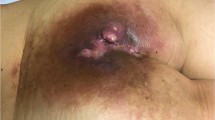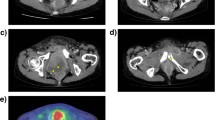Abstract
Six years after completion proctectomy, a patient presented with invalidating pain, fever and massive mucopurulent secretion through the perineal wound after completion proctectomy. CT-scan revealed a large presacral abscess and osteonecrosis of the sacrum. The patient consented to placement of an ENDO-sponge® (B. Braun Medical B.V., Melsungen Germany). On day 4 granulation tissue covered the walls of the cavity and the amount of necrotic tissue and fibrin was reduced. The foam was changed every 4 days and treatment was continued for 20 days. On day 20, vacuum assisted closure therapy was stopped and the remnant cavity was further rinsed with saline. There was no more evacuation of mucus or pus. Three months later, the patient was symptom free and only a small perineal dimple remained. ENDO-sponge® (B. Braun Medical B.V., Melsungen Germany) treatment is possible for presacral abscedation which is a well-known complication following abdominoperineal rectum amputation.
Similar content being viewed by others
Avoid common mistakes on your manuscript.
Introduction
Several studies have demonstrated that adjuvant radiotherapy for rectal cancer is not without morbidities. Complications, such as small bowel enteritis, obstruction, poor wound healing and breakdown, abscess formation, fistulisation and anastomotic strictures have all been reported in literature [1, 2]. Recently, endo-vacuum assisted closure (ENDO-VAC) therapy has been proposed as a novel approach for treating anastomotic leakage after rectal resection in patients without peritonitis or sepsis [3–6].
We report a case of chronic pelvic abscedation and osteonecrosis of the sacrum, following completion proctectomy, with consistent mucopurulent secretion from the perineum which was successfully treated with ENDO-sponge® therapy (B. Braun Medical B.V., Melsungen Germany).
Patient history and technique
A 76-year-old woman recently came to our observation. Sixteen years earlier, she had undergone an anterior resection of the rectum for a Dukes B adenocarcinoma of the sigmoid-rectal junction at another institution. The patient received adjuvant chemoradiation therapy. Postoperatively she developed a small abscess in the pelvis which was treated conservatively with antibiotic therapy.
In 1994, she underwent a Hartmann procedure for colonic obstruction due to a stricture at 10 cm from the anal verge on the site of the anastomosis. Postoperatively she developed chronic proctitis with anal mucus secretion and blood loss. Treatment with sucralfate enemas was unsuccessful. A completion proctectomy was performed in 2002. The perineal wound was left open.
Six years later, the patient presented for the first time at our institution for a second opinion. Since the reintervention in 2002 she complained of intermittent periods of fever, non-healing of the perineal wound, severe pain and massive mucopurulent secretion through the perineal wound. Dressings had to be changed every hour and for the last 6 years the problem lead to social withdrawal and isolation. Inspection showed a perineal wound with a small sinus of 1 cm. Digital dilatation of the sinus enlarged the opening and a massive amount of pus and mucus evacuated through the perineal wound. Further inspection of the hole in the perineum revealed a large presacral cavity.
CT-scan revealed a large presacral collection of 11 cm and osteonecrosis of the sacrum (Fig. 1).
Biopsies from the presacral cavity were taken to ensure that there was no recurrence of the neoplastic disease. Histologic examination was negative. The patient consented to placement of an ENDO-sponge® (B. Braun Medical B.V., Melsungen Germany). Four days later the cavity was flushed with saline and inspected using a flexible endoscope. The wall of the cavity was covered with fibrin and necrotic tissue (Fig. 2). After the abscess cavity was endoscopically rinsed, the size of the abscess cavity was estimated and the sponge was cut accordingly. The introducer sleeve was positioned over the endoscope and placed into the deepest part of the cavity under endoscopic vision. The sleeve was fixed in this position and the endoscope was withdrawn. The sponge was moistened with a lubricant, compressed and inserted into the introducer sleeve and advanced using a specially designed pusher to the deepest point of the cavity. Finally, the introducer sleeve and pusher were removed. The position of the sponge was controlled endoscopically (Fig. 3) and the evacuation tube, coming out of the perineal opening, was connected to a low vacuum suction bottle. Before applying negative suction, the base of the cavity was filled with stomal paste to prevent air leakage.
On day 4, the first sponge change took place under sedation. Granulation tissue covered the walls of the cavity and the amount of necrotic tissue and fibrin was reduced.
VAC-therapy was continued as an ambulatory treatment. The sponge was changed every 4 days in the outpatient clinic under endoscopic control. During subsequent treatment sessions the size of the cavity decreased as the cavity progressively filled with granulation tissue. The size of the sponge was reduced according to the decrease in cavity size. In total VAC-therapy was continued for 20 days (4 sponge changes). On day 20, VAC-therapy was stopped since the size of the cavity was so small that the sponge could not be introduced anymore. The remnant of the cavity was further rinsed with saline two times daily. There was no more evacuation of mucus or pus. Three months later, the patient was symptom free and only a small perineal dimple remained (Fig. 4). Currently, 5 months later, no further therapy is needed and the perineal dimple is epithelialised.
Discussion
A number of studies have shown a trend towards increased risk of pelvic septic complications and perineal wound complications due to perioperative radiotherapy for rectal cancer [7].
Following rectum amputation our patient developed a large abscess in the minor pelvis with non-healing perineal wound. The ideal treatment should control pelvic sepsis, speed up healing and closure of the presacral cavity despite radiotherapy necroses present within the cavity. The currently available therapies, such as endoscopic lavage or drainage aim at a secondary healing through continuous removal of septic wound secretions from the cavity. Sometimes the focus is sufficiently cleansed, but the chemotaxins necessary for secondary healing are also removed from the wound area. Vacuum assisted closure therapy accelerates wound healing by placing a polyurethane foam into a wound and applying a controlled negative pressure [8, 9]. It promotes healing of chronic wounds by an enhanced formation of granulation tissue, increasing vascularity and decreasing bacterial colonisation [8, 10]. Recently, several reports have been published using endo-VAC therapy for treating anastomotic leakage following anterior resection [3–6]. This method provides continuous drainage of the perianastomotic abscess and fistula in the pelvic region in combination with debridement and consecutive mechanical closure of the leak. No fixation of the drain is necessary. In these reports air tightness was maintained by the anus and the sfincter of the patient. In the presented case we used the endo-VAC system for treatment of a non-healing presacral abscess without active leakage since the patient underwent a completion proctectomy. Air tightness was achieved by placing stomal paste at the base of the cavity against the sponge. The reported case shows that endo-sponge treatment is also possible for a presacral abscess cavity with a non-healing perineal wound which is a well-known complication following abdominoperineal rectum amputation.
References
Ooi BS, Tjandra JJ, Green MD (1999) Morbidities of adjuvant chemotherapy and radiotherapy for resectable rectal cancer: an overview. Dis Colon Rectum 42:403–418
Palman L, Glimelius B, Frykholm G (1989) Ischaemic strictures in patients treated with a low anterior resection and perioperative radiotherapy for rectal carcinoma. Br J Surg 76:605–606
Weidenhagen R, Gruetzner KU, Kopp R, Spelsber FW, Jauch KW (2006) Role of vacuum therapy in the management of the septic abdomen. Zentrlbl Chir 131(Suppl 1):S115–S119
Nagell CF, Holte K (2006) Treatment of anastomotic leakage after rectal resection with transrectal vacuum assisted drainage (VAC). A method for rapid control of pelvic sepsis and healing. Int J Colorectal Dis 21:657–660
Weidenhagen R, Gruetzner KU, Wiecken T, Spelsberg F, Jauch KW (2008) Endoscopic vacuum-assisted closure of anastomotic leakage following anterior resection of the rectum: a new method. Surg Endosc 22:1818–1825
Mees ST, Palmes D, Mennigen R, Senninger N, Haier J, Bruewer M (2008) Endo-vacuum assisted closure treatment for rectal anastomotic insufficiency. Dis Colon Rectum 51:404–410
Kapiteijn E, Marijnen CA, Nagtegaal ID et al (2001) Preoperative radiotherapy combined with total mesorectal excision for resectable rectal cancer. N Engl J Med 345:638–646
Argenta LC, Morykwas MJ (1997) Vacuum-assisted closure: a new method of wound control and treatment: clinical experience. Ann Plast Surg 38:563–576
Morykwas MJ, Argenta LC, Marks MW, DeFranzo AJ, Molnar A, David LR (2006) Vacuum- assisted closure: state of the clinic art. Plast Reconstr Surg 117:127–142
Morykwas MJ, Argentas LC, Shelton Brown EI, McGuirt W (1997) Vacuum-assisted closure: a new method for wound control and treatment: animal studies and basic foundation. An Plast Surg 38:553–562
Author information
Authors and Affiliations
Corresponding author
Rights and permissions
About this article
Cite this article
D’Hondt, M., De Hondt, G., Malisse, P. et al. Chronic pelvic abscedation after completion proctectomy in an irradiated pelvis: another indication for ENDO-sponge treatment?. Tech Coloproctol 13, 311–314 (2009). https://doi.org/10.1007/s10151-009-0505-3
Received:
Accepted:
Published:
Issue Date:
DOI: https://doi.org/10.1007/s10151-009-0505-3








